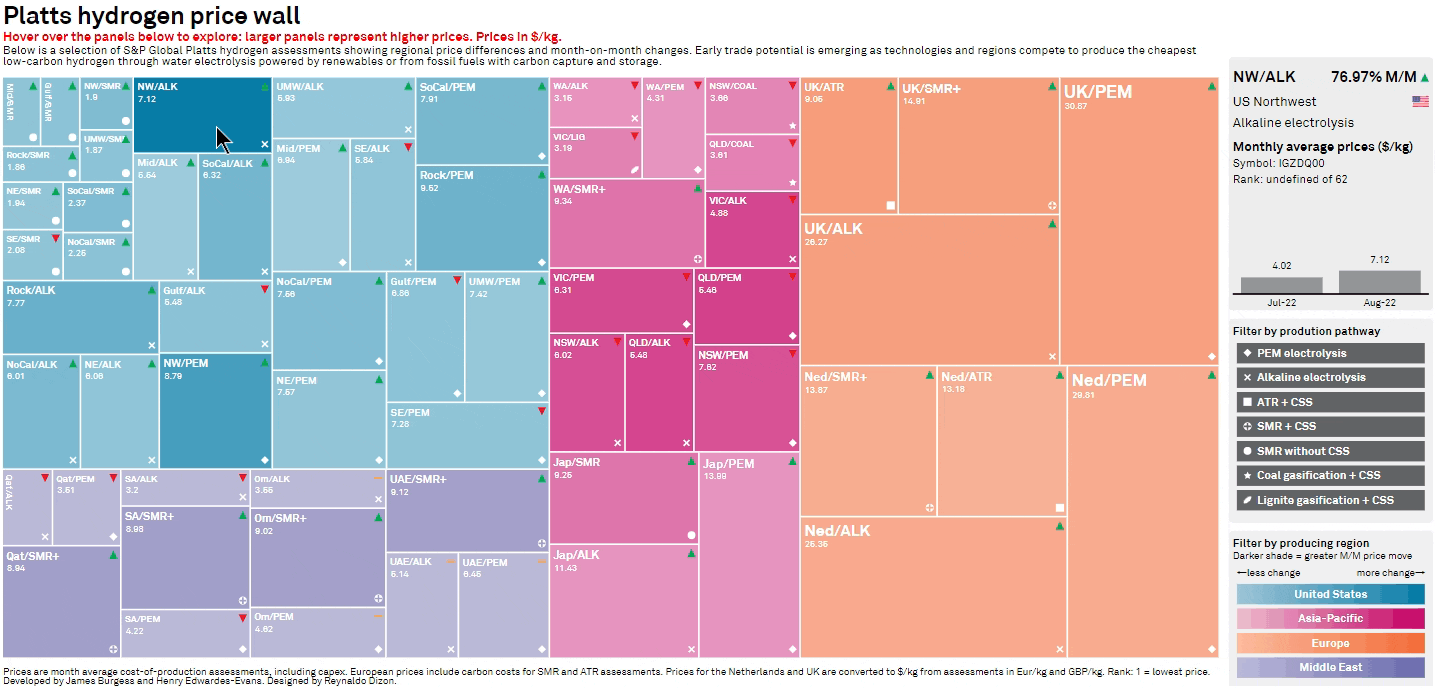The International Energy Agency sees momentum building in the electrolyzer sector, with manufacturing capacity ramping up globally, but has called for greater policy support to get hydrogen projects going in its Global Hydrogen Review 2022, published Sept. 22.
Not registered?
Receive daily email alerts, subscriber notes & personalize your experience.
Register NowThe IEA said global electrolyzer manufacturing capacity was expected to grow sixfold by 2025 to 50 GW/year, and also noted a proliferation of pilot projects in new applications such as steel and transport. However, these areas accounted for a small part of the hydrogen landscape.
"There are growing signs that hydrogen will be an important element of the transition to an affordable, secure and clean energy system, but there are still major advances in technology, regulation and demand needed for it to fulfil its potential," IEA Executive Director Fatih Birol said in a statement.
"Governments now need to implement concrete policies to remove regulatory barriers and support shovel-ready projects," Birol added.
"Low-emissions" hydrogen production in 2021 was less than 1 million mt, most derived from fossil fuels with plants using carbon capture facilities, in contrast to the overall global hydrogen demand of 94 million mt in 2021.
The IEA estimated that hydrogen demand could reach 115 million mt/year by 2030, rising to 130 million mt/year if governments fully deliver on current climate pledges, with over a quarter coming from low-carbon sources.
The IEA noted that the low-carbon hydrogen project pipeline continued to grow, but said only 4% of the projects were under construction or had taken final investment decisions.
If all projects came to fruition, low-carbon hydrogen production could reach 16 million to 24 million mt/year by 2030, the IEA said, with over half coming from electrolysis powered by renewables. This would imply around 134-240 GW of global electrolysis capacity, compared with around 500 MW in 2021.
However, 34 million mt/year of hydrogen production by 2030 would be needed to reach government pledges, rising to 100 million mt/year by 2030 if the world is to cut CO2 emissions to zero by 2050, the IEA said.
Demand for new hydrogen applications was up 60% in 2021, it added, but accounted for just 40,000 mt.
The report comes after industry association the Hydrogen Council also warned of a shortfall in projects to meet global climate ambitions.
Speaking at the S&P Global Hydrogen Markets Europe conference in Amsterdam on Sept. 20, Hydrogen Council VP Strategy and Policy Support Peter Mackey said capacity and projects were reasonably well aligned in the short term, but said that most of the projects it tracked remained in the announcement phase.
Mackey also identified a $460 billion gap in funding commitments to build out the hydrogen sector required to meet climate targets. In particular, he saw a significant underinvestment in the transport sector.
Policy support needed
Mackey said the industry needed "demand visibility" from policy makers to give them confidence and certainty for investment decisions, along with a speeding up of decision making.
Final investment decisions in Europe have been put on hold following the European Parliament's vote to relax the rules around the criteria for renewable hydrogen projects. While this is seen as a boost for the industry longer term, in the short term it creates uncertainty until the legislation is finalized, and project developers have paused FIDs until the rules are decided, delegates at the conference said.
The IEA also said a lack of demand creation could hinder final investment decisions, and called on governments to move from policy announcements to implementation.
The agency said governments could reduce risk and increase the economic feasibility of low-carbon hydrogen projects in a number of ways. These included demand creation through auctions, mandates and public procurement, ensuring gas pipelines and terminals were hydrogen and ammonia compatible and through establishing common industry standards, regulations and certificates.
Mackey said limited renewable power access and supply chain constraints for equipment and materials were also hindering the industry.
Signs of progress
The IEA said hydrogen project announcements in the steel sector were growing fast, just a year after the first pilot plant using hydrogen in the direct reduction of iron started operations.
Announced project using hydrogen and ammonia in the power sector come to almost 3.5 GW of capacity by 2030, while there are over 100 pilot projects for using hydrogen and its derivatives in the maritime sector.
The IEA report found that renewable hydrogen could already compete on price with fossil fuel-derived production in regions with good renewable resources that currently rely on fossil fuel imports for hydrogen production.
"Combined with the expected drop in the cost of renewable energy, this can bring the cost of renewable-based hydrogen down to a range of $1.3-$4.5/kg," the IEA said.
Platts assessed the lowest cost grid-based electrolytic hydrogen production at $2.58/kg in Qatar in August (alkaline electrolysis, including capex), compared with over $25/kg in the UK amid record-high month-ahead power prices, according to the S&P Global Commodity Insights hydrogen price wall.
Electrolyzer costs could fall by around 70% by 2030 if the planned scaling up in manufacturing capacity takes place, the IEA added.


